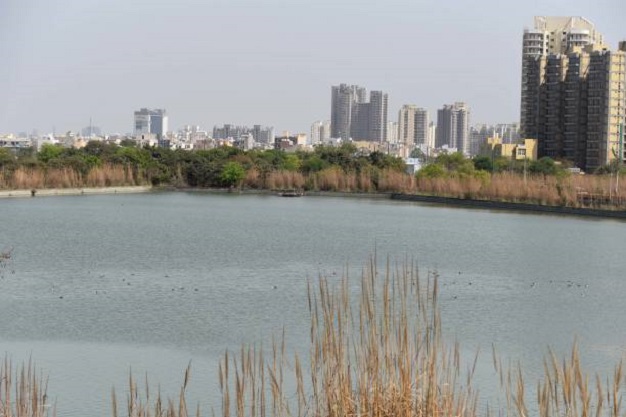Water

Gurgaon, once replete with water bodies, functioned as a thriving wetland until the 1960s. The Sahibi River channelled its waters into the Najafgarh Jheel basin, effectively capturing rainwater and runoff from the Aravalli hills. However, flood management projects designed to protect Delhi on one hand and the explosive real estate development on the other, have led to the disappearance or degradation of these vital water bodies.
Meanwhile, as Gurgaon’s population surged, so did the demand for water from residential, construction, industrial, and office sectors. In 2023, the demand stands at 637.2 MLD, while the supplied water is 570 MLD, revealing a significant shortfall. Currently, borewells dug by Municipal Corporation of Gurgaon and developers are bridging this gap. By 2041, with an estimated population of 66.2 lakhs, the city’s water requirement is projected to reach approximately 1,480.9 MLD.
Gurgaon sources its water from three major sources: Canal water (from the Yamuna River), Treated Sewage Water, and Groundwater. Water from the Western Yamuna Canal (WYC) flows through the Gurgaon Water Supply (GWS) Canal, originating from Kakaroi village and terminating at Basai. The National Capital Region Canal (NCR canal) was constructed to supplement the water supply and originates from the Yamuna River at Munak in Haryana.
However, canal water doesn’t reach the entire city, leading to extensive groundwater extraction, which adversely impacts the water table. Groundwater is depleting rapidly, receding at an average rate of 1.5 meters per year over the last decade. The current average groundwater level in the city is approximately 38.7 meters. Overuse for construction, limited rainwater harvesting, and rapid urbanization are contributing factors.
Gurgaon’s water supply and management involve various agencies, including the Municipal Corporation of Gurgaon, the Haryana Urban Development Agency, the Gurgaon Metropolitan Development Authority, and Public Health and Engineering Department. These agencies are responsible for the distribution of canal water and treated sewage water. GMDA controls the master water supply and sewerage network, while MCG manages internal lines. Water pollution falls under the purview of the Haryana State Pollution Control Board, and groundwater is managed by the Central Ground Water Board.
Gurgaon possesses five sewage treatment plants (STPs), with a combined capacity of 388 MLD, discharging effluent into the Najafgarh drain. The city also hosts four water treatment plants, but there’s a need to enhance their capacity.
Despite an annual rainfall of 600-700 mm, the city hasn’t fully embraced rainwater harvesting. Poor maintenance of existing rainwater pits has rendered many dysfunctional, and there’s room for creating more in parks and public spaces. The MCG has mandated rainwater harvesting for various establishments, while several Resident Welfare Associations (RWAs) actively practice it.
Gurgaon faces waterlogging issues due to inadequate drainage systems. As urbanization progresses, the city’s ground’s ability to absorb water diminishes, causing flooding. This problem has remained largely unresolved since the infamous 2016 incident. Various areas are still prone to flooding due to clogged storm water drains and concretization of natural drains.
Previously, water bodies acted as flood buffers and helped recharge the water table. Of the 644 water bodies in Gurgaon, a study found that 153 are beyond recovery, 53 face severe threats, 132 are contaminated, and 44 experience seasonal waterlogging.
Efforts to revive some water bodies are underway, including initiatives by Gurujal and “I am Gurgaon.” These revived water bodies offer not only natural beauty but also public spaces for relaxation. Besides, GMDA is also planning to lay a 20.5 km master supply pipeline from Basai water treatment plant to the city’s tail-end areas, to ensure water supply to every part of the city.
Gurgaon needs city-wide, community-wide, and individual-wide efforts to ensure water security. Initiatives like large scale water recharge programs and promoting rainwater harvesting, undertaking decentralized wastewater treatment, tracking and auditing tube wells and bore wells, maintaining storm water drains, and raising awareness are vital at the city level. RWAs and buildings can undertake rainwater harvesting and recycling of grey water. At an individual level, people can take measures to save water and conserve it.
The challenge is to provide clean, reliable, and affordable water while preserving the district’s groundwater. A collective effort is needed to ensure a water-secure Gurgaon.
SourcesWATER Sustainability Assessment of Gurugram City
Garden Estate Rainwater Harvesting System
